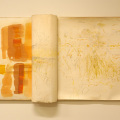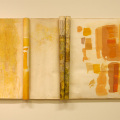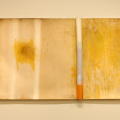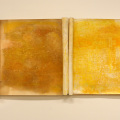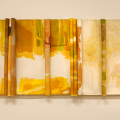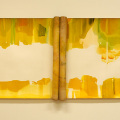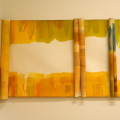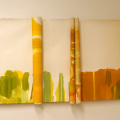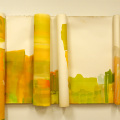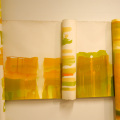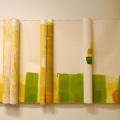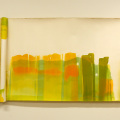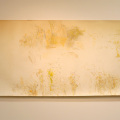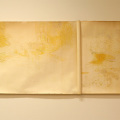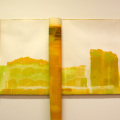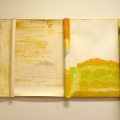Jeff Doring
Lives and works at Origma Bird Sanctuary, Glenorie, NSW
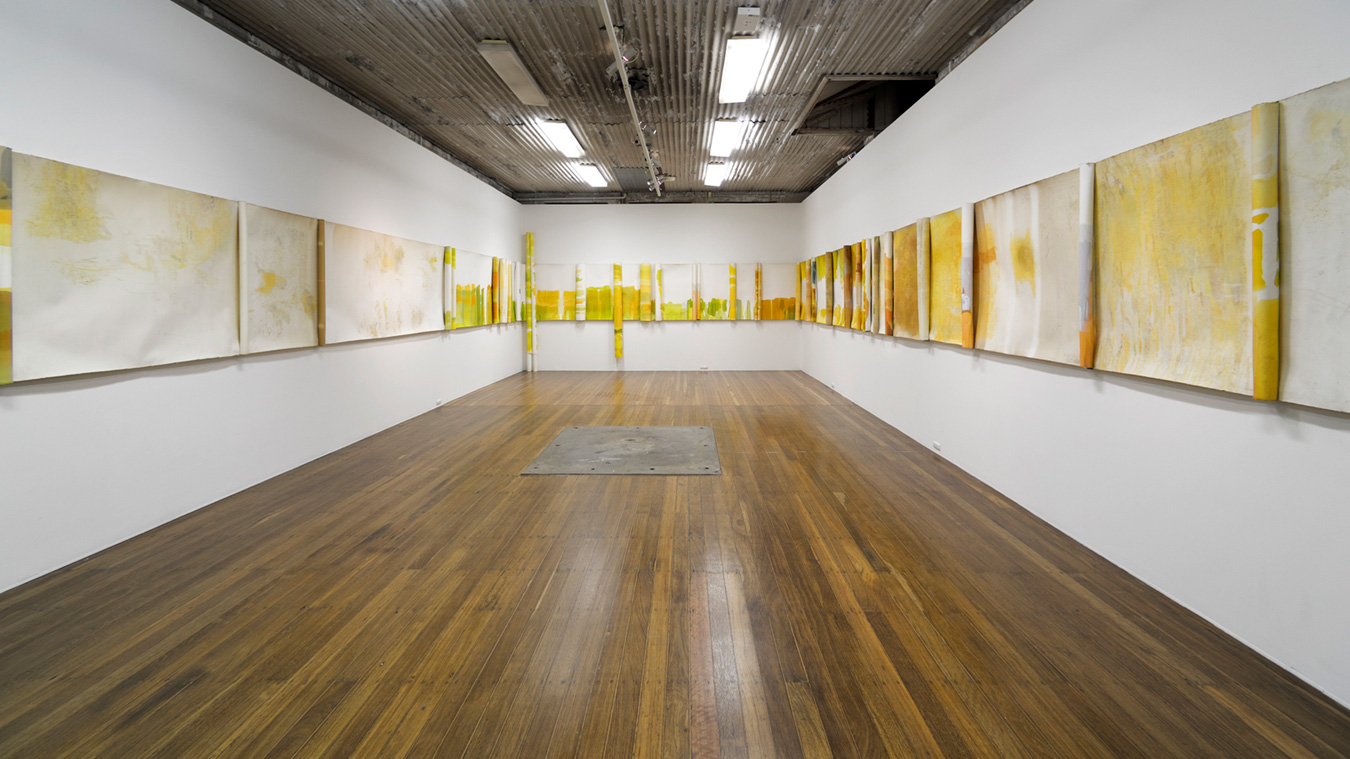
works in the exhibition:
After a fire the bush shoots with fresh green 2013-2016
pencil, crayon, pigment and acrylic wash, smoke on Arches paper
dimensions variable, approximately 30 linear metres x 1.4m (h)
White 2016
1080p HD video, 50:00
photography and sequencing by Jeff Doring
Lux 2016
1080p HD video, 50:00
photography and sequencing by Jeff Doring
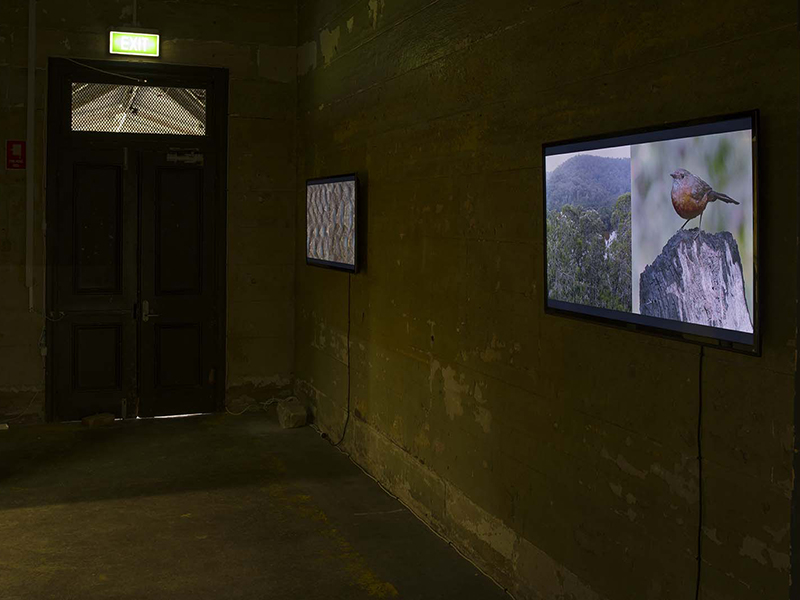
photographic diptych sequences Lux (left) and White (right) by Jeff Doring photo: Carl Warner
catalogue text:
Jeff Doring is an artist, photographer and filmmaker who has lived off-grid in the bush north-west of Sydney for over 40years. He recently succeeded in having the property listed as a Conservation Area by the NSW State Government, an acknowledgement of his decades long care-taking of the important habitat types and complex biodiversity present there.
Over this time, Jeff has built up an extensive ‘bush diary’ of daily photography, and an ever expanding paper continuum of intricate drawings and evocative ‘running water’ brushless pour paintings made in response to experiences of light, weather and life encounters with other species of all sizes and kingdoms, especially that most evocative of inter-species contacts, the ‘eye-to-eye’. His practice involves a music-like flow of spontaneity and intuition, drawing and painting in response to daily events, sparks of thought, and flows of recollection of friends and events in the streams of memory.
In the following paragraphs, Jeff offers thoughts on the installation he has created for Fieldwork – After a fire the bush shoots with fresh green.
ON WHITE
“Colour is a narrow band of the electro-magnetic spectrum…” and similar offerings, are exceptionally opaque descriptions restricted to academic formulae and descriptive terminology insisting on some certainty that avoids the fluid indications of mobility our experience of colour stimulates. All colour is affected or changed by its proximity to strong or weak whites, and my pursuit of variations in whites, as defined by a sandstone country palette of colours, has been the motivation in my drawing and painting practice over many years.
WHITE
The colour theme throughout is white – wet and dry whites of many kinds as defined by neighbouring and surrounding colours. My first memory after the fire1 is of summer flora whites of paperbark trees (“snow in summer”) flowering when fire occurred, started to celebrate the very whites that the fire eliminated briefly, before becoming regrowth greens etc that is a vibrant section changing the quality of white.
Hence a title from an old Mornington Island song:
“After a fire the bush shoots with fresh green, or farewell with the promise of renewal of friendship.”
Techniques include two contrasting qualities of white;
DRY WHITE
This is what Yolgnu artist Narritjin Maymuru taught me when photographing him working at dawn on the dunes at Djarrokpi, with the days first sunlight coming low from the beach across the bark he was painting. We started talking about about birryun – the same white sunlight light we share with ancestors everyday that bounces off leaves and the ground, birryun white being the very origin of white crosshatching on barks that in my work have become fine lines and details engraved in paper with colours superimposed so birryun penetrates everything, and white spreads across all the drawings like sand that comes from high caves and rain carries downhill then ultimately collects as beach on the edge of the creek.
WET WHITE
The term ‘flying’ white comes from fluid painting that Chinese artists of the brush evolved when applying liquid colour, to deliberately leave behind untouched paper as gaps in black ink.
In my work, seen in pours and vertical poles of colour, ‘flying white’ only comes from using water and paint. When the colour flies across the surface of paper, with skill the painter can leave behind spaces of white paper inside a colour. In my case I have developed a way to produce various exact shapes like quartz pebbles or turtle bubbles, stones found near caves, or the flash of white on the throat of an azure kingfisher etc…but all instinctive and only suggestive, anyway, both are essential elements of this landscape here.
WHITE PX
The long sequence of WHITE pix photos show many references for all the local Origma Bird Sanctuary whites – from the paperbarks that flower once days of summer heat arrive, leaving swathes of white flotsam drifting on creekwater, while turtles travel back and forth beneath this floating white ceiling. Also the azure kingfisher, herons, egrets and many other birds here are first seen due to white plumage and markings.
WHITE is also at play when the drawing paper becomes illuminated from behind, for shadows with sunlight, for musical movement across the long wall.
TWO WHITES: BIRRYUN and FLYING WHITE
I must use two, making three kinds of white. One the everywhere sunlight reflected off leaves etc that Narritjin said was the one we share with the ancestors, because it is the same light they were looking at, and therefore it must be woven throughout a bark, (hence the rarrk cross hatching on bark paintings etc).
I have always been frustrated applying white ‘on top’ of other colour – it seems contrived and disturbing somehow. Anyway, one day, the power of experience so strong, I had to draw with a bone, then rub over with dry ochre. There it was, the perfect way to ‘mention’ other ideas while drawing some place….connecting spontaneity with memories of conversations and observations…they belong together in the person.
Ungwanaka’s words come back from a conversation in camp one morning west of Kata Jutaa:
“…you came from that direction and I came from that direction but we are both looking at the same thing…”
FLYING WHITE
The source of the flying white technique is the azure kingfisher who had to be portrayed. So one day this artist decided to brush liquid paint across the paper, then lift it back for a split second during the wave of the hand, making the paint miss touching the paper and leaving a clear space of ‘flying white’.
When composing a lengthy path of colour the incidental flying whites give extra details and movement…
Jeff Doring
Origma Sanctuary 2016
1 In December 2002, Jeff’s bushland home and surrounding forests were completely destroyed in a devastating firestorm. He lost decades of work and the majority of his worldly belongings. After a fire the bush shoots with fresh green is an expression of the gradual concurrent return of organic life to Origma Sanctuary and creative life to the artist, after ‘The Fire’.
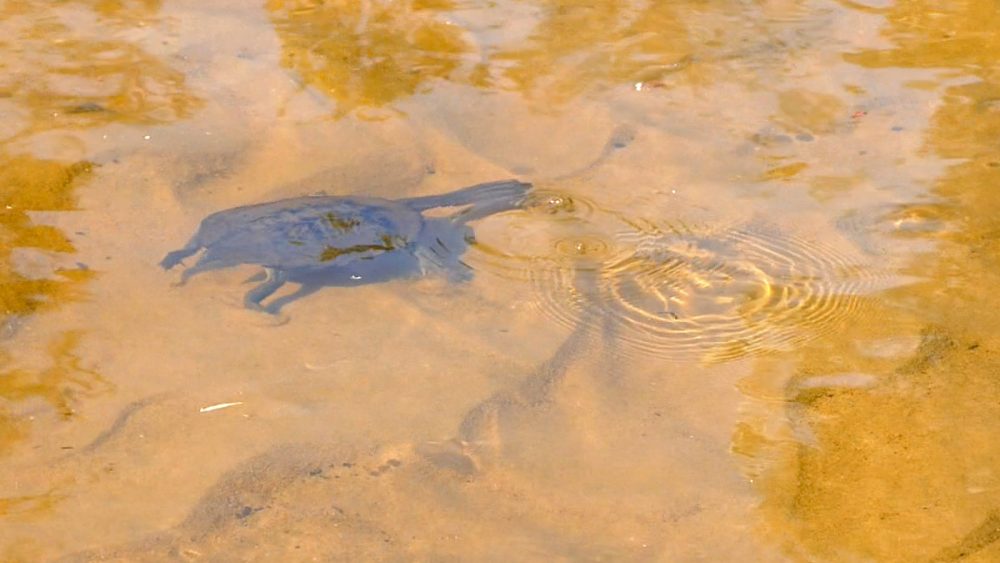
Eastern long-necked turtle (Chelodina longicollis) in Origma Creek photo: Jeff Doring
